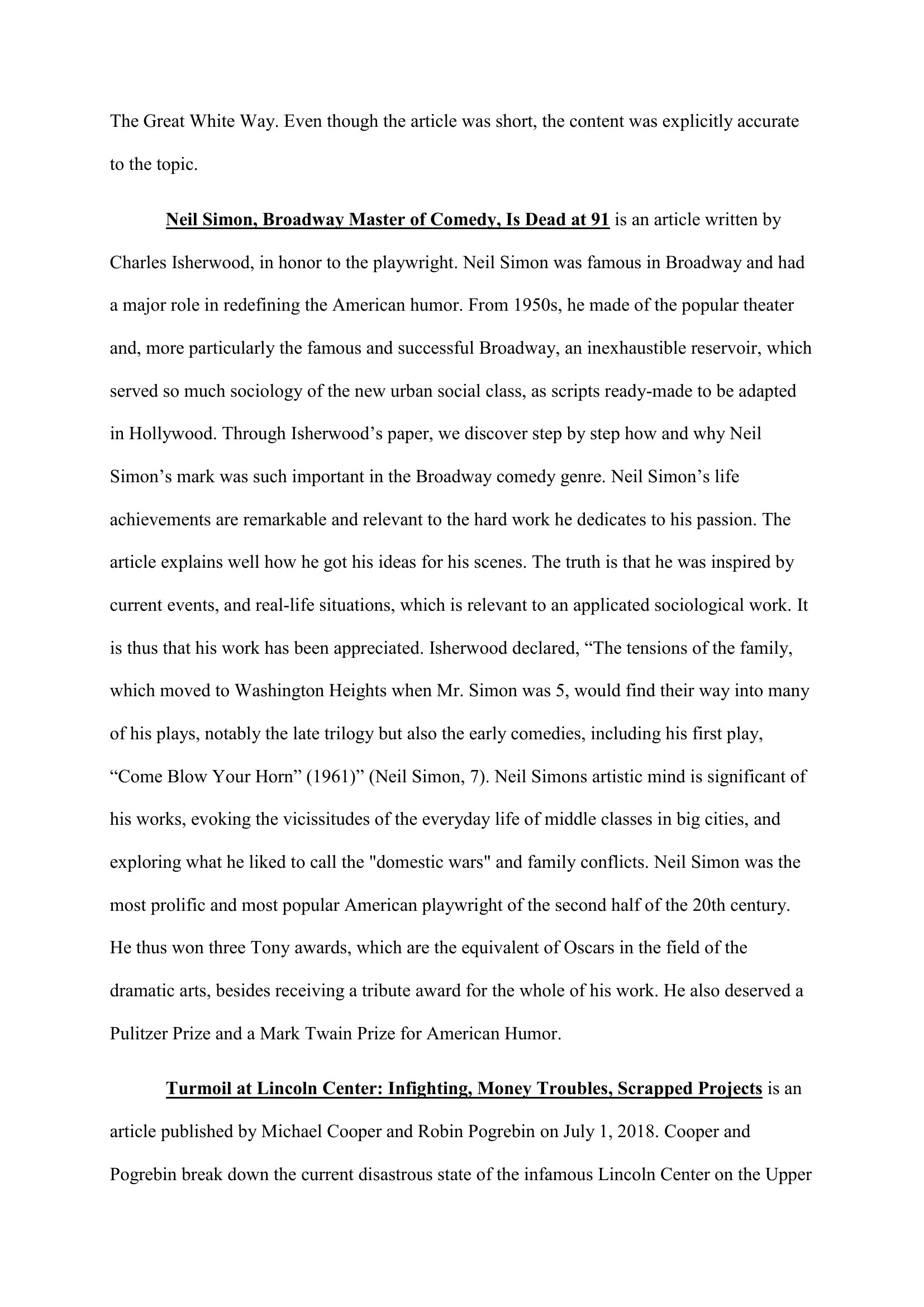Article Paper Assignment
Publié le 01/03/2020
Extrait du document
Article Paper Assignment
How Broadway became Broadway is an article written by Keith Williams on October 26th, 2017. This article is very interesting for me because I love going to Times Square to watch movies and I always see the Broadway’s theaters, which catch my attention every time, on my way to the cinema. Most of the world know that Broadway is famous for its artistic, musical and theatrical expositions. However, only few know how it became so famous. It is thus through Williams’s article that we familiarize with the magnificent story of Broadway. Although the Civil War was a terrible event in America history, it has benefited Broadway in a wonderful way. Keith Williams declared, “Tours were suddenly possible because of significant expansion and improvements to the nation’s railroad network, made for military purposes during the Civil War” (How Broadway Became Broadway, 2). Thus, external factors played a big a role in the expansion of Broadway’s popularity. Railroad allowed people to transport all their equipment, costumes, and sets in the country. Accordingly, it made the scenes more attractive and gained considerable audiences. Jennifer Ashley Tepper, a theater historian and producer, declared, “After the Civil War, the phrase ‘direct from Broadway’ emerged in advertising when shows traveled to other cities” (How Broadway Became Broadway, 2). Broadway shows were a pride across all the country. It was relevant to its success. It was around the same time that Broadway was becoming known as “The Great White Way” because of its electric advertisements. I always wondered from where came the idea of the ads in Times Square. I was surprised to learn that it first appeared in Broadway. In conclusion, the article was very informative and interesting. I learned a couple of things like the popularity of Broadway at that time, the effect of railroads, and the
«
The G reat White Way.
Even though the article was short, the content was explicitly accurate
to the topic.
Neil Simon, Broadway Master of Comedy, Is Dead at 91 is an article written by
Charles Isherwood, in honor to the playwright .
Neil Simon was famous in Broad way and had
a major role in redefining the American humor.
From 1950s, he made of the popular theater
and, more particularly the famous and successful Broadway, an inexhaustible reservoir, which
served so much sociology of the new urban social class, as sc ripts ready -made to be adapted
in Hollywood. Through Isherwood’s paper, we discover step by step how and why Neil
Simon’s mark was such important in the Broadway comedy genre.
Neil Simon’s life
achievements are remarkable and relevant to the hard work he d edicates to his passion.
The
article explains well how he got his ideas for his scenes.
The truth is that he was inspired by
current events, and real -life situations, which is relevant to an applicated sociological work.
It
is thus that his work has been appreciated.
Isherwood declared, “ The tensions of the family,
which moved to Washington Heights when Mr.
Simon was 5, would find their way into many
of his plays, notably the late trilogy but also the early comedies, including his first play,
“Come Blow Yo ur Horn” (1961) ” (Neil Simon, 7).
Neil Simon s artistic mind is significant of
his works , evok ing the vicissitudes of the everyday life of middle classes in big cities, and
exploring what he liked to call the "domestic wars" and family conflicts.
Neil Simon was the
most prolific and most popular American playwright of the second half of the 20th century.
He thus won three Tony awards , which are the equivalent of Oscars in the field of the
dramatic art s, besides receiving a tribute award for the whole of his work.
He also deserved a
Pulitzer Prize and a Mark Twain Prize for American Humor .
Turmoil at Lincoln Center: Infighting, Money Troubles , Scrapped Projects is an
article published by Michael Cooper and Robin Pogrebin on July 1, 2018 .
Cooper and
Pogrebin break down the current disastrous state of the infamous Lincoln Center on the Upper.
»
↓↓↓ APERÇU DU DOCUMENT ↓↓↓
Liens utiles
- note article descola
- exposé Henry Cochin, article « A propos de quelques tableaux impressionnistes »
- DIDEROT ET D'ALEMBERT : ENCYCLOPEDIE : ARTICLE REFUGIES
- Hobbes, article 14: L'état de nature dans Léviathan et Le Citoyen
- Weekly assignment







